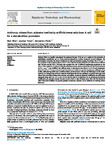Antimony release from polyester textiles by artificial sweat solutions: A call for a standardized procedure
| dc.contributor.author | Biver, M | |
| dc.contributor.author | Turner, Andrew | |
| dc.contributor.author | Filella, M | |
| dc.date.accessioned | 2021-09-20T09:48:11Z | |
| dc.date.issued | 2021-02 | |
| dc.identifier.issn | 0273-2300 | |
| dc.identifier.issn | 1096-0295 | |
| dc.identifier.other | 104824 | |
| dc.identifier.uri | http://hdl.handle.net/10026.1/17836 | |
| dc.description.abstract |
Polyester fibres are usually contaminated by antimony because of its use as a catalyst in the production of polyethylene terephthalate and as a flame retardant synergist in a variety of new and recycled polymers. The present study determined the release of antimony (at total concentrations ranging from about 125 to 470 μg g-1) from polyester textile samples designed to be in contact with human skin using standard artificial sweat solutions (ISO 105-E04 and EN 1811). The study also examined the role of different experimental parameters on the release of the metalloid. Overall, and using the default parameters, between about 0.05 and 2% of total antimony (or 0.1-1 μg g-1) was mobilized into artificial sweat. A reduction in time (from 24 to 12 h) and temperature (from 37 to 20 or 4 °C) and an increase in pH (from 5.5 to 7) resulted in a decline in antimony mobilization from textiles, while altering textile mass to solution volume and the presence of lactate had little impact on the results. Removal of a filtration step increased antimony mobilization but this was attributed to artefacts associated with release from microfibres during extract storage and analysis. In general, antimony mobilization was sufficiently repeatable using either EN 1811 or ISO 105-E04 but the latter is recommended for an assessment of antimony mobilization and potential exposure because its pH is closer to that of human sweat. Since the first fraction of either extractions mobilized the greatest quantity of antimony, exposure can be minimized by washing articles before use. | |
| dc.format.extent | 104824-104824 | |
| dc.format.medium | Print-Electronic | |
| dc.language | en | |
| dc.language.iso | en | |
| dc.publisher | Elsevier | |
| dc.subject | Antimony | |
| dc.subject | Synthetic fibres | |
| dc.subject | Clothes | |
| dc.subject | Sweat | |
| dc.subject | Mobilization | |
| dc.title | Antimony release from polyester textiles by artificial sweat solutions: A call for a standardized procedure | |
| dc.type | journal-article | |
| dc.type | Journal Article | |
| plymouth.author-url | https://www.webofscience.com/api/gateway?GWVersion=2&SrcApp=PARTNER_APP&SrcAuth=LinksAMR&KeyUT=WOS:000604740600006&DestLinkType=FullRecord&DestApp=ALL_WOS&UsrCustomerID=11bb513d99f797142bcfeffcc58ea008 | |
| plymouth.volume | 119 | |
| plymouth.publication-status | Published | |
| plymouth.journal | Regulatory Toxicology and Pharmacology | |
| dc.identifier.doi | 10.1016/j.yrtph.2020.104824 | |
| plymouth.organisational-group | /Plymouth | |
| plymouth.organisational-group | /Plymouth/Faculty of Science and Engineering | |
| plymouth.organisational-group | /Plymouth/Faculty of Science and Engineering/School of Geography, Earth and Environmental Sciences | |
| plymouth.organisational-group | /Plymouth/REF 2021 Researchers by UoA | |
| plymouth.organisational-group | /Plymouth/REF 2021 Researchers by UoA/UoA07 Earth Systems and Environmental Sciences | |
| plymouth.organisational-group | /Plymouth/Research Groups | |
| plymouth.organisational-group | /Plymouth/Research Groups/BEACh | |
| plymouth.organisational-group | /Plymouth/Research Groups/Marine Institute | |
| plymouth.organisational-group | /Plymouth/Users by role | |
| plymouth.organisational-group | /Plymouth/Users by role/Academics | |
| dc.publisher.place | Netherlands | |
| dcterms.dateAccepted | 2020-11-13 | |
| dc.rights.embargodate | 2021-9-21 | |
| dc.identifier.eissn | 1096-0295 | |
| dc.rights.embargoperiod | Not known | |
| rioxxterms.versionofrecord | 10.1016/j.yrtph.2020.104824 | |
| rioxxterms.licenseref.uri | http://www.rioxx.net/licenses/all-rights-reserved | |
| rioxxterms.licenseref.startdate | 2021-02 | |
| rioxxterms.type | Journal Article/Review |


